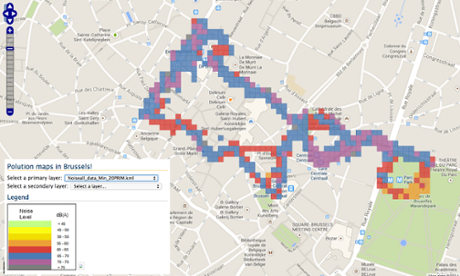
Noise pollution in cities is causing our health to suffer: according to the World Health Organisation, one in five Europeans is regularly exposed to sound levels at night that could significantly damage their health, leading to cardiovascular diseases, sleep disturbance and stress. Until recently, monitoring these noise levels has been left up to local councils, but researchers at the Free University of Brussels in Belgium have developed an app that allows everyone who downloads it the ability to measure the amount of noise they’re exposed to by transforming their smartphone into a sound level meter.
NoiseTube works by recording sound levels and GPS locations. Once launched the app shows decibel levels of green or red depending on the level of noise. That information is then sent to the NoiseTube server via the internet where a detailed ‘noise map’ is produced and then made available to the user. “The app is very simple to use on purpose. We wanted everyone to be able to use it even if they weren’t tech savvy,” Dr Ellie D’Hondt of the NoiseTube project said. “We see this as a tool that empowers communities to take control and monitor their own noise levels.”
The project started in 2008 as a new form of data gathering, one that was close to people and of a social concern. “Sound was an obvious choice because everyone has a microphone on their mobile phone, and noise pollution, along with air pollution is an environmental concern. Often the two go hand in hand,” D’Hondt said.
Since its launch, the app has been popular with community groups who want to collaboratively tackle noise pollution. According to D’Hondt these groups don’t think that city produced noise maps give an adequate interpretation of the level of noise they’re experiencing. City produced noise maps, which are required by the European Union for all urban populations of over 250,000, are based on statistical models involving very few actual measurements. NoiseTube on the other hand gives a detailed account of the level of noise experienced at a specific time and location. “Ten people walking the same area from 9 to 10am every day for one week can make a valid and detailed map for an area of a couple of blocks,” D’Hondt said. “It’s a reasonable effort by the community group to produce these maps, and with it they can go to authorities and have real evidence about what they’re experiencing.”
So far these sorts of collaborative noise maps have been produced for a number of European cities, including Antwerp and Brussels. The app has been downloaded by 10,000 people with 2,700 people registered on the NoiseTube website.

